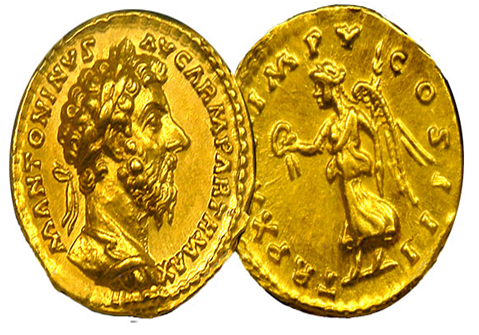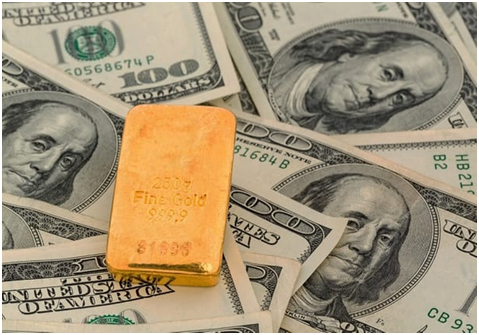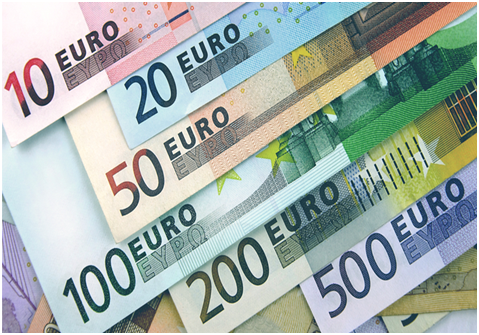.png)
The objective of this chapter is to talk about the evolution of the Forex market, from the earliest known method of exchange - the barter system - to the currently used method of exchange - the free float system. In this chapter, we will talk about each of the major landmark systems of exchange that have eventually shaped the Forex market of today. So, let us begin.
The Barter system
The barter system is the earliest known method of exchange. It is believed to have originated among the Mesopotamian tribes sometime around 6000 B.C. Back then, bartering was confined to local areas, where people used to exchange goods for items such as food, beverages, and spices. As time progressed, the barter system spread beyond local areas. During the middle ages, the bartering system spread across countries and continents, where people from one country and continent started to exchange goods and services with people from other countries and continents. Not only were the necessity items such as food and beverages exchanged during this time, but also non-essential items such as crafts, artistic works, perfumes etc. were exchanged.
Put it in simple words, bartering system is a method wherein goods and services are exchanged for other goods and services without any involvement of money. As an example, a person who has surplus rice but needs salt might exchange it with someone who has surplus salt but needs rice. This is an example of bartering because the exchange is taking place without any involvement of money. During the ancient times, before the advent of money, all the transactions used to take place in the form of bartering. For instance, a person who had excess milk and didn’t need to consume as much, could either exchange it for other goods that he or she needed or for services that he or she needed, such as repairing house, fitting a light etc.
However, there were complications in the bartering method of exchange. As we can see from the above examples, bartering can take place when the requirements of both the sides are met. Without this, it is difficult to exchange goods and services for other goods and services. For instance, a person who has surplus rice but needs salt is likely to be unsuccessful in selling it to someone who has surplus salt but has no requirement of rice. As such, at times, it became very difficult to find a suitable buyer for the surplus goods and services that one possessed and needed those to exchange for something else. The other difficulty that arose with this system was the way to measure the value of goods and services. For instance, if one person had surplus rice and needed to exchange it for salt, how much quantity of rice equated a certain quantity of salt? This question was highly subjective and was usually determined by the need and the bargaining ability of the two parties.
Because of the complications of the barter system, the need to develop a better and a convenient medium of exchange arose. A medium that could be measured in value terms, a medium that was more convenient to carry, a medium that was durable and non-perishable, and a medium that would be readily acceptable by any buyer and seller. The barter system eventually lost its appeal to the gold system (in some case even silver was accepted, though it had a lower appeal than gold), wherein gold gradually started to become the standard medium for exchanging goods and services.
The Gold era
The major complications of the bartering system eventually paved way for gold to be considered as a medium of exchange. Ever since the ancient ages, people have been fascinated by the aura of gold. The metal has been considered as a symbol of status since the ancient times because of its unique features such as visual appearance, scarcity, durability, and divisibility into smaller denominations. These features of gold along with its ready acceptance and measurability in terms of value, made the yellow metal a preferred medium for exchanging goods and services across the world. Around the year 560 BC, the first officially known gold coins were minted in the region of Lydia, which in now a part of Turkey. Eventually, the usage of gold coins as a medium of exchange spread to other parts of the world. Civilizations in Europe from Rome to Greece also started issuing gold coins as a medium of exchange.
However, as time evolved and the global trade started expanding, there came a need to move to a new system of exchange. One of the reasons for this was the inconvenience of carrying huge quantities of gold for making large transactions. Another problem that arose was related to storage. It started to become increasingly difficult and risky to store large quantities of the precious metal at home or at any other place. Yet another problem was related to the tampering of gold coins - what if a person melts the gold coin and reduces the gold content in it by a small portion before forging the coin again? All these issues eventually led to the adoption of the Gold Standard in the 19th century.
The Gold Standard
By the early 17th century, gold was the most dominant method of exchange around the world. The yellow metal was readily accepted by every buyer and seller as a medium of exchange. What however became problematic was the inconvenience to carry gold whenever there was a need to transact. The larger the transaction, the larger the quantity of gold that was needed to be carried along. Eventually, to address this issue, people started depositing gold with goldsmiths on whom they could trust. These goldsmiths, in return, would issue depository receipts to the tune of gold that was deposited with them. These receipts, instead of the physical gold, would then be used as a medium of exchange between a buyer and a seller. The person holding these receipts could go to the goldsmith with whom the gold was deposited and exchange it for gold, as and when needed. These receipts were a type of paper money, because they were valuable and represented a promise to pay gold as and when the holder of these notes demanded them.
As the trade started getting bigger and bigger, a lot of these depository receipts were issued. Eventually, due to the ever-expanding volumes and number of transactions, a lot of these goldsmiths grew into private banks. They now started not only issuing promissory notes whenever someone deposited gold with them, but also lending excess gold from their vault at a certain rate of interest. This is how the process of depositing and lending began back when currency notes were not in existence. Eventually, as the global trade expanded at a rapid pace and as the government needed someone from whom it could borrow money by issuing debt, there came a need for the development of an entity that could act not only as a regulator for the growing numbers and volumes of the deposits and lending but also as a lender to the government. This led to the growth of central banks. The Riksbank of Sweden was the first recognized central bank, established in the year 1668. It was a few years later followed by the establishment of the Bank of England in 1694. Other central banks in different parts of Europe were also established over the course of the next few decades. These entities not only provided funds to their government, but also acted as a banker’s bank because they held the deposits of other banks.
Eventually, as the global trade flourished, as the acceptance of gold-backed promissory notes became more pronounced, as the number of private banks started expanding, and as the role and importance of central banks grew, there was a need for the development of a more robust monetary system. This, in the early 19th century, led to the adoption of the “Gold Standard” system, with England officially adopting it in 1819. Gradually, most of the countries followed suit and started adopting the Gold Standard system. Under this system, the central banks started issuing paper money, by backing them to the amount of gold they had in their vaults. The greater the amount of gold they had in their vaults, the greater the number of paper money they could print, and vice versa.
The price of gold was decided by the central bank, which in turn would determine the value of the currency. For instance, if the Bank of England fixes the price of gold at, say, £20 per troy ounce, the value of one unit of the Great Britain Pound (GBP) would be (1/20) the value of an ounce of gold. As we can see, if the central bank fixes gold at a higher price, the value of the currency would drop, and vice versa. This way, central banks could adjust the value of its currency depending on various factors such as demand and supply conditions. When needed, people could go to the banks and exchange paper money for a certain quantity of gold.
One of the benefits of this system was that the paper money in circulation was backed by the quantity of gold in a central bank’s vault. As such, central banks could print only as much money as the quantity of gold they possessed. This in turn helped to rein in inflationary pressures(greater the money in circulation in the economy, higher the inflation, and vice versa). Gold Standard system benefited nations which enjoyed a Balance of Payment surplus, as they received gold tothe tune of their surplus, which they could then use toincrease the money supply of their own currency. However, this came at the cost of the nations that had a Balance of Payment deficit, who had to settle this deficit by giving gold, which would reduce the quantity of gold in their reserves and in turn reduce their ability to increase the money supply.
The Bretton Woods system
The Gold Standard system worked very well during the 19th century, but things started to change in the early parts of the 20th century. While the supply of gold was growing because of continued mining of the metal, it nonetheless was growing at a slower pace as compared to the growth of the world economy. More importantly, as World War I inched closer, the governments of various nations needed considerable sums of money to fund for war-related expenses. However, as we know by now, the existing Gold Standard system put a cap on the amount of money that could be printed. As a result, confidence in the Gold Standard system started eroding.Post World War 1, nations also needed a lot of money for rebuilding their economies following the devastation caused by the war as well as the economic devastation caused by the Great Depression a few years later in 1929. As a result, countries started abandoning the Gold Standard system. England abandoned the Gold Standard system in 1931, while the US followed suit two years later.
By the end of World War 1, the US had become a major economic power. It had overtaken England as the world’s largest economy, it had the largest reserves of gold in the world,and it was also a major gold producing nation. Also, by the end of World War 1, the US had become a net creditor nation, meaning other nations owed more to the US than the US owed to them. Back then, as the balance of payment differences were settled in gold, this led to a strong influx of gold into the US, further bolstering the nation’s gold reserves. Because of all these factors, the Dollar became a dominant global currency. A lot of nations who had abandoned the Gold Standard system started pegging the value of their currency to that of the Dollar rather than to gold.
In 1944, as World War 2 was ending, the major Allied Powers - the US, England, and France - along with a few other countries met in Bretton Woods,US, to talk about moving on from the Gold Standard system to a new international system. After seeing the instability and the inflexibility caused by the Gold Standard system during the war years, the major Allied forces as well as other countries believed there was a need to develop a more robust system which would be more stable and flexible. As a result, it was decided during this meet in Bretton Woods that the value of other currencies be pegged to the value of the Dollar, which in turn would be pegged to the value of gold. The reason why the Dollar waschosen was because of the growing strength of the US economy, as highlighted earlier, and because of the apparent safety of the US – it was one of the very few major powers in the world on whose land war did not officially enter. Meanwhile, the reason why the Dollar was pegged to gold was because the US could do it – it had the largest gold reserves in the world, which continued expanding rapidly because of the US's status as a creditor nation and because of strong gold mining in the US.
Hence, in 1944, a new international system was introduced and was called the Bretton Woods system (named after the place of the meet). Under this system, the Dollar became the world's reserve currency, against which the values of other currencies were fixed within a band of 1%. The value of the Dollar, meanwhile, was fixedto that of gold at the then existing parity of $35 a troy ounce. In other words, countries that wanted to convert a dollar to gold could do so at $35/oz. As we already know, before the Bretton Woods agreement, the balance of payment differences was settled using gold. After the agreement however, the balance of payment differences was settled using the Dollar. As a result, countries around the world started accumulating dollarsin their reserves rather than accumulating gold. As the Dollar was fully convertible to gold, when necessary, countries could freely convert their dollar holdings into gold, on demand.
The system worked excellently for a few years as it helped to promote stability and order. A lot of nations that were devastated by the effects of World War 2 were able to recoverand make economic progress during the time of the Bretton Woods system. However, just like its predecessors, the Bretton Woods system started showing cracks in the 1960s. Because of the expansionary monetary policy in the US and improving economic conditions across several European countries, the US started experiencing a balance of payment deficit. As such, the gold reserves of the US started depleting. This, coupled with rising inflationary pressures around the world, made the gold parity price of $35/oz to appear as quite undervalued (and the Dollar as overvalued).Also, increased spending by the US government to fund for the Vietnam war and other activities led to an increase in the amount of dollars in circulation. By the end of the 1960s, the gold that the US had in its vault started falling short of the dollars in circulation. Fearing a run on its gold reserves by the member nations as well as reluctance of the member nations to revalue their own currencies against the Dollar, the US finally ended the Dollar-to-gold convertibility in 1971, bringing an end to the Bretton Wood system.
The Free-Floating system
The end of the Bretton Woods system in 1971 eventually gave birth to the free-floating system within the next couple of years. Under this system, major currencies around the world could freely float against each other. In other words, the value of one currency against that of the other was determined by the market forces of demand and supply. A lot of countries adopted the free-floating system, which became the dominant international system following the end of the Bretton Woods agreement. As a result, currency revaluations took place over the following months to reflect fair values of various currencies vis-a-vis those of the others. While a lot of things changed under the free-floating system, one thing that did not change was the role of the Dollar. The US currency continued to be the world’s reserve currency and a lot of countries continued to accumulate dollars in the form of their foreign exchange reserves. The free-floating system is prevalent today as well.
Under this system, movements in currencies are determined by macro-economic factors such as interest rates, monetary and fiscal policy, economic health of a nation, geopolitical issues, capital flowsetc. Currency movements are also impacted by short-term factors such as speculation, reaction to a news or to an economic data etc. For instance, in case of EUR/USD currency pair, the USD is likely strengthen against the EURin case signs emerge that economic conditions in the US are better than those in the Eurozone, or if the monetary policy of the Federal Reserve were to tighter more than that of the European Central Bank.
While under the free-floating system, currencies arepermitted to freely float, central banks can and do intervene in the Forex market whenever needed. For instance, whenever any adverse movements in currencies threaten the economic stability of a nation or reduce the nation’s competitiveness overseas, central banks can intervene in the Forex markets by buying or selling its currency. Recent examples include the interventions made by the Swiss National Bank and the Bank of Japan in 2011 to protect their respective currencies from strengthening further against the Euro and the Dollar, respectively.
In a later chapter, we will talk more about floating exchange rate and compare it with fixed exchange rate, which some countries use even today.
Introduction of the Euro
The euro, also known as the common currency, is the official currency of 19 nations that are members of the Eurozone. The currency was introduced on 1st January 1999, nearly 7 years after the signing of the Maastricht Treaty.This treaty created, amongst others, the European Union (EU), the European Central bank (ECB), and the Euro.At the time of its introduction, the Euro was accepted in 11 nations - Austria, Belgium, Finland, France, Germany, Ireland, Italy, Luxembourg, Netherlands, Portugal, and Spain. Back then, the Euro was introduced only in electronic form, primarily for making electronic payments. The physical coins and notes were introduced 3 years later, on 1st January 2002, a day when the Euro replaced every currency of the 11 member nations mentioned above. The major objectives behind introducing the Euro were to facilitate ease of trade between member nations and to also eliminate currency risk that existed between member nations.
Today, the membership of the Euro has expanded to 19 nations. Besides each of the 11 nations mentioned above, the 8 other nations that accept the Euro today are Cyprus, Estonia, Greece, Latvia, Lithuania, Malta, Slovakia, and Slovenia. While the European Union has a total of 28 members, only 19 of those accept the Euro. The remaining 9 nations - Bulgaria, Croatia, Czech Republic, Denmark, Hungary, Poland, Romania, Sweden, and the United Kingdom - either failed to meet the criteria set forth in the Maastricht Treaty or didn’t want to switch to another currency.
Today, the Euro is the second most traded currency as well as the second most held reserve currency in the world. Furthermore, the pair EUR/USD is the most traded currency pair in the world. After being introduced in 1999 at an exchange rate of $1.17, EUR/USD fell below parity to a trough of $0.82 within two years of its introduction. From this trough, the common currency gained markedly against the Dollar, peaking at $1.60 in July 2008. As the US sub-prime crisis spread outside the US, the Euro came under increasing selling pressure against the Dollar and began its major downtrend. Adding to more pressure were the worsening of the Eurozone sovereign crisis and the subsequent policy actions taken by the ECB and EU officials to save member nations. The common currency eventually bottomed in January 2017 at $1.03. However, it has failed to gain much ground, undermined by negative interest rates in Europe and strength of the US economy.
The Digital era
The Forex market has come a long way over the past few centuries. From the earliest known Barter Exchange system to the now existing Free-float system, a lot of structural changes have taken place over the years to facilitate a smoother and a transparent global trade.
Today, we live in a world that is defined by digitalization. The tremendous surge in volumes over the past two decades coupled with major technological advances have simplified Forex trading considerably. Today, people can trade various Forex instruments by making just a few clicks on the phone or on the web. Two decades ago, such luxury (and not even all of these!) were available only to commercial banks and large institutions.
With technology continuing to improve at a rapid pace, participation in Forex market is likely to increase manifolds in the coming years. This should further narrow down the trading spreads and thereby lower the transaction costs further.
Next Chapter
Comments & Discussions in
FYERS Community




Rohit commented on August 23rd, 2019 at 4:10 PM
Hi Sir,
When will be Cross Currency pair like GBP/USD, EUR/USD available for trading?
tejas commented on August 28th, 2019 at 6:31 PM
Hi Rohit, It's on the agenda but there are barely any volumes or demand for international pairs in India. We'll try to implement it soon.
Shloka P commented on August 23rd, 2019 at 4:14 PM
Hi Tejas
Have been waiting for this module for a long time. Thank you for all previous modules as well.
Is any strategy or technical tool for knowing a trend in currency contract?
tejas commented on August 28th, 2019 at 6:32 PM
I'll be writing more on this in the future. Stay tuned!
Prasad commented on August 23rd, 2019 at 4:20 PM
Hello, thank you for such a good explanation.
Currency charts in foreign exchanges are continuous whereas in India we see a lot of gap-up and gap-down in open. Why so?
Can we trade by the following pattern in the charts of foreign exchange currency for Indian currency contracts?
tejas commented on August 28th, 2019 at 6:36 PM
Hi Prasad, The futures market for currencies closes at 5:00 PM. Any price movement after 5 PM will not be captured in the chart on the same day.
Vinay A commented on August 23rd, 2019 at 4:21 PM
Good Day!
What are brokerage charges on Forex futures in Fyers?
tejas commented on August 28th, 2019 at 6:37 PM
0.01% < 20 per executed order. There is no change in pricing.
Appala commented on April 23rd, 2020 at 5:28 AM
Hi Tejas, Excellent explain on on Forex and other needful topics. Its very easy and simple Language like me.
Thanks,
Appala
Shriram commented on April 23rd, 2020 at 8:10 AM
Hi Appala, thank you for your valuable feedback!